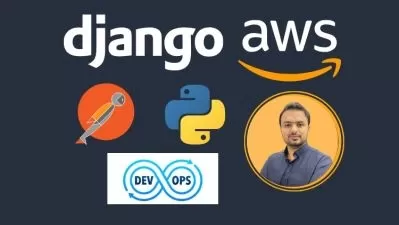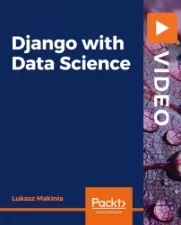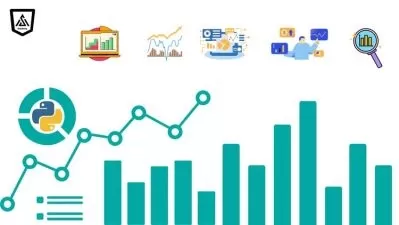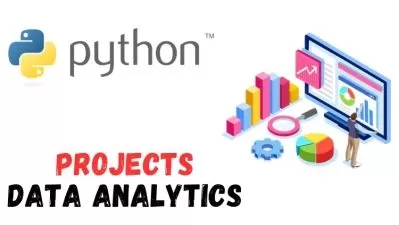Python Programming: Your First Django Web Application
Justin Mitchel
4:33:15
Description
Learn how to leverage Python's leading Web Development Framework to connect with users everywhere.
What You'll Learn?
- Python version 3.10 (or 3.8+)
- The fundamentals of Django
- Collecting data from users
- Rendering HTML templates and documents
- Password-protected pages & user-type permissions
- Modeling data in Django as it relates to a spreadsheet
- Dynamically display content based on stored database data
Who is this for?
More details
DescriptionBuilding a web application has never been easier thanks to open source. In this course, we're going to go step-by-step building a Django web application. If you've never used Django before, this is the course for you.
Django is one of the most popular web frameworks written in the Python programming language. Django and Python are both open source and free to use commercially. This means you don't have to pay a dime to create amazing software and impact people all around the world. Django powers many websites in the world including: Instagram, Pinterest, NASA, Baserow, this website, and so many others.
The goal of this course to teach you the fundamentals of Django while also creating a very practical project. Building something real is important because it gives you the context of how, when, and where to use a lot of Django's great features.
Django sits right in the middle of creating an app from scratch and using something like Wordpress. This means we have a lot of features we could implement along with a lot of features that just work by default. This makes Django incredibly flexible so that we can go far beyond what a blogging platform offers while being faster than starting from absolute 0.
For our User Interface, we're going to learn the fundamentals of Bootstrap. Bootstrap makes our Django project look far more professional in very little time. Not only that, we'll also have a much better user experience by leveraging many of Bootstrap's built-in features.
If we were building a house, Django would be the plumbing, the walls, and electricity while Bootstrap is the interior decorator.
Here's a few things we'll cover:
Django version 4.1 (or even 2.2+)
Python version 3.10 (or 3.8+)
Bootstrap 5.2+
Collecting data from users
Rendering HTML templates and documents
Password-protected pages & user-type permissions
Modeling data in Django as it relates to a spreadsheet
Dynamically display content based on stored database data
Much more
Who this course is for:
- Beginner Python developers looking to learn how to build web applications
- Anyone interested in using Django
- Anyone interested in collecting user data using open source software
- Entrepreneurs looking to test their ideas with minimal amount of code
Building a web application has never been easier thanks to open source. In this course, we're going to go step-by-step building a Django web application. If you've never used Django before, this is the course for you.
Django is one of the most popular web frameworks written in the Python programming language. Django and Python are both open source and free to use commercially. This means you don't have to pay a dime to create amazing software and impact people all around the world. Django powers many websites in the world including: Instagram, Pinterest, NASA, Baserow, this website, and so many others.
The goal of this course to teach you the fundamentals of Django while also creating a very practical project. Building something real is important because it gives you the context of how, when, and where to use a lot of Django's great features.
Django sits right in the middle of creating an app from scratch and using something like Wordpress. This means we have a lot of features we could implement along with a lot of features that just work by default. This makes Django incredibly flexible so that we can go far beyond what a blogging platform offers while being faster than starting from absolute 0.
For our User Interface, we're going to learn the fundamentals of Bootstrap. Bootstrap makes our Django project look far more professional in very little time. Not only that, we'll also have a much better user experience by leveraging many of Bootstrap's built-in features.
If we were building a house, Django would be the plumbing, the walls, and electricity while Bootstrap is the interior decorator.
Here's a few things we'll cover:
Django version 4.1 (or even 2.2+)
Python version 3.10 (or 3.8+)
Bootstrap 5.2+
Collecting data from users
Rendering HTML templates and documents
Password-protected pages & user-type permissions
Modeling data in Django as it relates to a spreadsheet
Dynamically display content based on stored database data
Much more
Who this course is for:
- Beginner Python developers looking to learn how to build web applications
- Anyone interested in using Django
- Anyone interested in collecting user data using open source software
- Entrepreneurs looking to test their ideas with minimal amount of code
User Reviews
Rating
Justin Mitchel
Instructor's Courses
Udemy
View courses Udemy- language english
- Training sessions 32
- duration 4:33:15
- Release Date 2023/03/16















